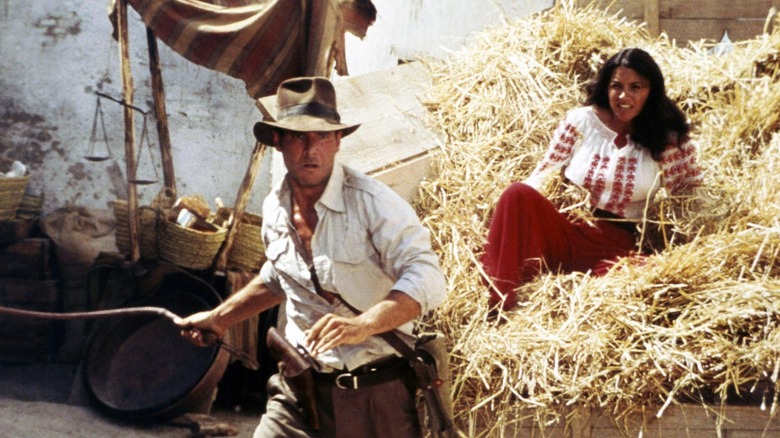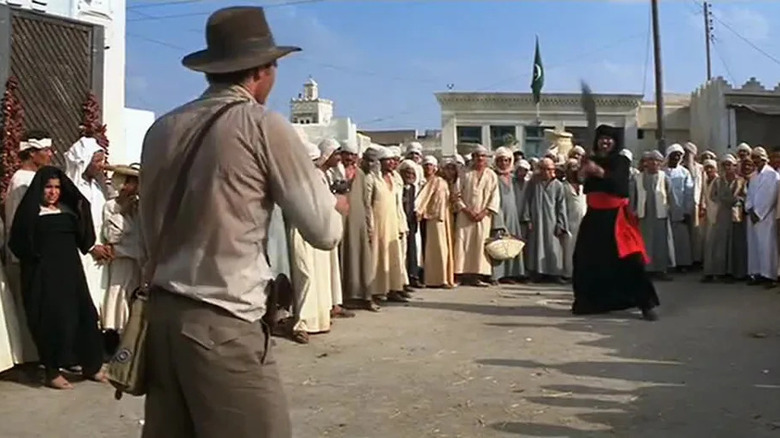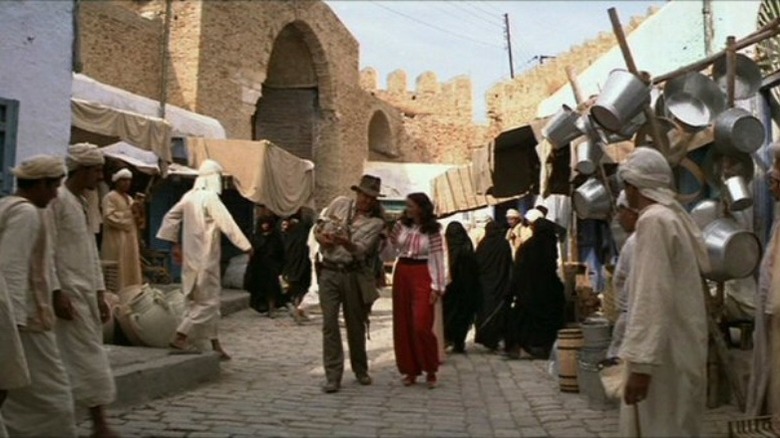Six Hundred Thirsty Extras Threw Raiders Of The Lost Ark's Set Into Chaos
There is a chase sequence about halfway through Steven Spielberg's "Raiders of the Lost Ark" that takes place in the streets of Cairo. Indiana Jones (Harrison Ford) and Marion Ravenwood (Karen Allen) are targeted by Nazis and other bad guys, and the two are separated. Marion hides in a basket, while Indy wastes a few weapons-wielding bad guys searching for her. To populate the streets of Cairo (actually filmed in Kairaouan, Tunisia), Spielberg had to hire hundreds and hundreds of extras to work in the blistering Tunisian sun.
Filming in Kairouan was, by all accounts, a pretty horrible experience. Temperatures were reportedly over 130°, and many, many members of the crew ended up contracting cases of dysentery from the local food. Spielberg himself only ate food that he brought with him from England, so he was supposedly spared. Although the streets of Kairouan looked authentic to the period Speilberg wanted — "Raiders of the Lost Ark" is set in 1936 — no one on the "Raiders" crew realized until they arrived that homes were festooned with TV antennas. An entire day of filming was lost to the meticulous removal of said antennae. Spielberg, feeling ambitious, actually wanted to hire over 2,000 extras to appear in the Cairo sequences. Ultimately, however, unable to find that many people, Spielberg had to settle for 600.
According to the 1981 book "The Making of Raiders of the Lost Ark" by Derek Taylor, those 600 extras weren't treated as well as they might have been. No meals were arranged and, distressingly, no widespread source of water was provided. In 130° heat, this was a grave oversight, and the crew members, at the last minute, tried to arrange drinks from a visiting fire truck. That, as one might imagine, didn't go over very well.
Don't mess with the locals
David Wisnievitz, one of the members of the sound department, related the water crisis, pointing out that the "Raiders" production had failed to consider most of the extras, notably the ones dressed in turbans. The extras who were hired to play European characters were featured in more indoor scenes, and their needs were seen to. Wisnievitz's comments revealed a streak of prejudice at work. The "Raiders" crew came up with a hasty water source that didn't work out very well, and that wasn't distributed well:
"It began when the six hundred extras started asking urgently for water. They were very, very thirsty. You know how we had been drinking water from those ice-cold bottles all morning? Well, they had nothing. [...] A fire truck was brought, and when the water started to come up there was much more going on the ground than they were able to drink; literally twice as much was being spilled. They were screaming and fighting for it."
He noted that the sight of six hundred people fighting over firetruck water that was rapidly spilling onto the ground certainly made for good documentary footage — in that grim Wener Herzog sort of way — but that's about all the experience was good for. "We got great shots for the documentary, I should tell you that," he said, "but it was a real bad scene."
What's more, the water was very hot. When word got back to Steven Spielberg about the water crisis, he felt the need to step in.
'Steven was angry'
It seems that keeping water inside the metal tanks of a firetruck that had also been out in 130° heat really didn't help matters. While many of the locals were dismissive of others, Spielberg would be damned if he didn't give his extras something cool to drink. Wisnievitz recalled:
"Steven was really angry. The water was almost too hot to touch anyway, out of a fire truck that had been out all day in that heat. Steven said he doesn't care who they are or how they have been treated before, they are going to get proper food and drink. You know they treat the horses better than they treat the people out here on this location. Even the goats are better off."
Eventually, everyone got the water they needed.
Ford, perhaps infamously, was said to have contracted dysentery during the shoot in Tunisia, and was supposed to have more fighting and action. Stuntman Terry Richards, who played a mean-looking baddie with an outsize cutlass, has retold the story often about how he was meant to attack Indiana Jones. Richard says that he had been practicing his sword skills for weeks, hoping to perform an impressive dance of violence for the film. When it came time to shoot the sword scene, Ford, tired and likely ill, merely extracted his gun and shot Richards. The flip moment removed a fight scene but is incredibly funny. Sometimes, it seems, necessity — and dysentery — really is the mother of invention.


